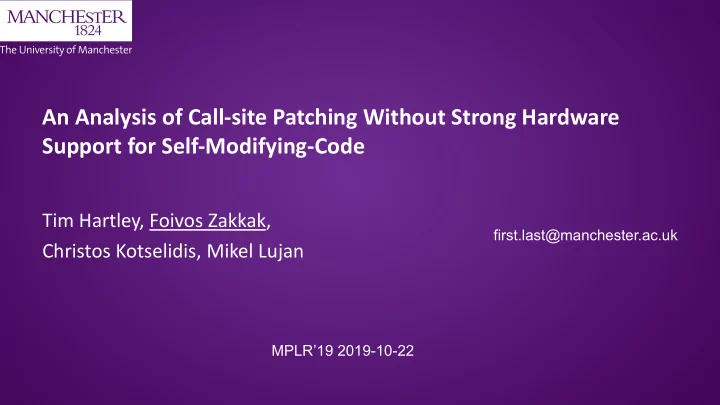

An Analysis of Call-site Patching Without Strong Hardware Support for Self-Modifying-Code Tim Hartley, Foivos Zakkak, first.last@manchester.ac.uk Christos Kotselidis, Mikel Lujan MPLR’19 2019-10-22
Call-Sites Direct branching Indirect branching Method A Method A call/jmp <offset> ld target, 0xabcd Memory call/jmp target Method B Method B Method C Method C 2019-10-22 MPLR’19 @foivoszakkak 2
Call-Site Patching § Tiered compilation § De-optimization § Etc. 2019-10-22 MPLR’19 @foivoszakkak 3
JIT compilation and Caches Main Memory 1 Code-stream vs Data-stream I-CACHE 001010101010110 010101010100101 0 11 00 1 00 11 00 111 1. Code gets fetched to I-Cache 3 1 000 1 0 1 0 1 0 1 0 1 00 1 000 1 0 1 0 1 0 1 0 111 2. Data get fetched to D-Cache 1 000 1 0 1 0 1 0 1 0 1 00 0 11 00 1 00 11 00 111 3. CPU executes code from I-Cache CPU 010101010101010 111110101010100 4. CPU writes data to D-Cache 6 010100100010101 100110010000011 5. D-Cache writes-back to memory 100110010000011 8 7 4 11 000 1 00 111 00 1 0 6. D-Cache fetches code to be edited 1 0 1 0 1 0 1 00 1 00 1 0 1 1 0 1 0 111 00 1 00 111 7. CPU writes code to D-Cache 1 0 1 0 1 0 1 00 1 00 1 0 1 11 00 1 0 1 00 1 00 1 0 1 D-CACHE 8. D-Cache writes-back code 111110101010100 5 2 2019-10-22 MPLR’19 @foivoszakkak 4
Low-power architectures and call-site patching § Fixed size instructions – Limit the range of direct branches/calls • +- 128MiB on AArch64 • +- 1MiB on RISC-V – Require multiple instructions to perform long-range calls AArch64 128MiB x86-64 240MiB 2019-10-22 MPLR’19 @foivoszakkak 5
Low-power architectures and call-site patching (cont.) § Weak memory models and self-modifying-code (SMC) support – SW explicitly issues memory barriers – Code-stream handled separately from data-stream (need to sync them) § Not all instructions are safe to patch – ARM (armv7 and armv8) and IBM (Power) limit the instructions that are safe to be patched while executing • Even if using atomic writes 2019-10-22 MPLR’19 @foivoszakkak 6
Patchable call-site implementations in AArch64 Direct Branching (short-range only) Relative-Load Indirect Branching B TARGET CALLEE_1 : .quad 0 x0123456789ABCDEF ... CALLEE_N : .quad 0 x01234ABCDEF56789 START : ... LDR X16, CALLEE_1 BLR X16 Absolute-Load Indirect Branching Trampolines (OpenJDK approach) MOVZ X16, #0xABCD ; Craft the address L: LDR X16, CALLEE MOVK X16, #0xEF89, lsl #16 ; holding BR X16 ; Don 't link MOVK X16, #0x7654, lsl #32 ; the CALLEE: .quad 0 x0123456789ABCDEF MOVK X16, #0x0213, lsl #48 ; target START: ... LDR X16, [X16] BL SHORT_TARGET ; or L BLR X16 2019-10-22 MPLR’19 @foivoszakkak 7
Comparison of call-site implementation approaches 2019-10-22 MPLR’19 @foivoszakkak 8
Evaluation Setup § Odroid-C2 – Quad-core Cortex-A53 @ 1.54GHz (pinned) • 8-stage pipelined processor with 2-way superscalar, in-order pipeline – 2 GB DDR3 RAM – Ubuntu 18.04.02 LTS – Kernel: Odroid 3.16..68-41 – GCC 8.3.0 – MaxineVM 2.8.0 – OpenJDK 8 u212 2019-10-22 MPLR’19 @foivoszakkak 9
Microbenchmark § Generates inline call-sites § Callers are ret-only methods § To patch we call a patcher method instead of a ret-only § Patcher always patches the next call-site (allows us to control number of patches § Patcher performs the necessary barriers as it would in a real system 2019-10-22 MPLR’19 @foivoszakkak 10
Microbenchmark results 2019-10-22 MPLR’19 @foivoszakkak 11
Dacapo and MaxineVM § We take the best two performing approaches (Direct and Relative-Load Indirect) and evaluate them with DaCapo using MaxineVM § We had to tweak Relative-Load Indirect to make it work with MaxineVM – Due to its metacircular nature, MaxineVM can only operate with offsets (relative branches), since at boot image creation the absolute targets are not known yet Indirect-Maxine ADR X17, CALL ; Get address of BLR LDR X16, OFFSET ; Load offset ADD X16, X16 , X17 ; Add them B #8 ; Jump over inline offset OFFSET: .int CALL - CALLEE_1 CALL: BLR X16 2019-10-22 MPLR’19 @foivoszakkak 12
Indirect-Maxine in Microbenchmark results 2019-10-22 MPLR’19 @foivoszakkak 13
DaCapo Results 2019-10-22 MPLR’19 @foivoszakkak 14
Conclusions § OpenJDK’s method seems the best for AArch64 since it penalizes only long-range branches and avoids explicit instruction cache invalidations on callers. – If you have a higher #"#$%&'($%) *(""+ #+,#'-&'($%) *(""+ ratio then maybe Relative-Load is better § The most promising approach in theory would be combining the following gadgets Indirect (long-rang) Direct (short-range only) ADRP X16, CALLEE ADD X16, X16, :lo12:CALLEE B TARGET BLR X16 – On AArch64 this is not possible though since ADRP and ADD cannot be safely overwritten if they are being executed concurrently with the modifications. 2019-10-22 MPLR’19 @foivoszakkak 15
Recommend
More recommend